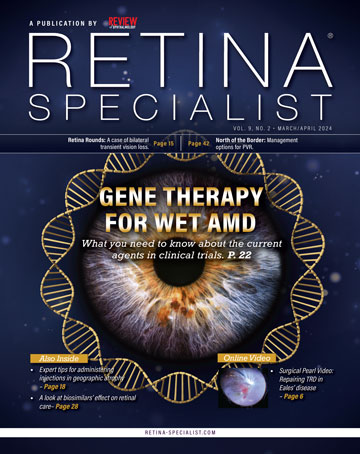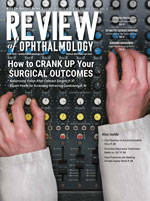| By Richard Mark Kirkner, Editor |
 |
| With Eleonora Lad, MD, PhD |
 |
Photobiomodulation is a novel concept in treating retinal disease. It involves using a device to deliver low-level light to specific areas of the retina to stimulate cellular response. Two investigative devices are evaluating this concept: Valeda Light Delivery System (LumiThera) and Retilux (PhotoOpTx).
The Valeda device has been the subject of 24-month results from the LIGHTSITE III trial in patients with dry age-related macular degeneration.1 The study reported minimal safety risks and high compliance. More than 80 percent of patients completed the trial.
In the LIGHTSITE III trial, treated patients also had statistically significant improvement in best-corrected visual acuity. Thirteen-month results reported that more than half of treated eyes had a more than 5-letter gain in best-corrected visual acuity. The 24-month results paralleled those findings.
The technology is already approved in Europe and South America for treatment of dry AMD, with an additional indication for diabetic macular edema in Europe. LumiThera reports that more than 9,000 patients worldwide have received the treatment.
Here, Eleonora M. Lad, MD, PhD, vice chair of ophthalmology at Duke University Medical Center in Durham, N.C., answers questions about the Valeda device and the LIGHTSITE III trial. Dr. Lad is a trial investigator and a member of LumiThera’s scientific advisory board.
Q: What is photobiomodulation (PBM) and how does the Valeda device work?
A: PBM uses low-light at specific wavelengths to stimulate healthful cellular function. It has been used in other specialties besides ophthalmology, including physical therapy, rheumatology for arthritis, cardiology and sports medicine, and it has been used in wound repair.
Valeda uses three specific wavelengths: 590, 660 and 850 nm. Each has a specific role in the cells they target. They are:
- 590 nm inhibits vascular endothelial growth factor expression and removes cellular deposits.
- 660 nm promotes oxygen binding and stimulates adenosine triphosphate (ATP), which inhibits inflammation and cellular loss.
- 850 nm stimulates metabolic activity as well as ATP, inhibits inflammation cellular loss and drives electron transfer.
Q: What can you tell us about the LIGHTSITE III Trial design?
A: LIGHTSITE III enrolled subjects with dry AMD with BCVA of 20/30 to 20/100 (n=100; 148 eyes). Average age was 75 years and the mean diagnosis was 4.9 years. The double-masked, control trial randomized patients 2:1 to PBM or active sham, which was a low-dose treatment of 50 to 100 times less than the two lowest doses.
Q: What was the take-home from the 24-month results?
A: The trial met the primary endpoint of BCVA improvement with a statistically significant difference between the treatment and sham groups. The results showed a sustained mean increase of >5 letters from baseline at both the 13 and 21 months. The improvement from baseline to 24 months was 5.9 letters vs. 1 letter for sham.
The treatment also demonstrated safety. No signs of phototoxicity or other side effects were reported through 24 months.
Q: What other notable results did the trial produce?
A: Another key finding was that 58 percent of the PBM-treated eyes had >5-letter gain, with a mean of 8.5 letters gained.
Also, a detailed morphology analysis using optical coherence tomography showed that fewer treated eyes developed geographic atrophy compared with sham: 5.7 percent (5:88) vs. 21.6 percent (11:51). That was statistically significant (p=0.003).
Additionally, 26.5 percent of PBM patients gained >10 letters and a small number of them, 5.5 percent, had a >15-letter improvement in BCVA vs. 1.9 percent of sham.
Q: What types of dry AMD patients would be best suited for PBM?
A: Those analyses are ongoing. It’s important that more than 55 percent of eyes had a >5-letter gain because that’s not the natural progression of this disease. Typically these eyes lost 2 to 3 letters per year. The natural history studies have been consistent on that. We would love to understand who those patients are who gain >5 letters, and who are the patients who gain >10 or even 15 letters.
Our reading center at Duke University and other collaborators are evaluating the OCT characteristics of these patients to identify structural features that will help us predict who might have the best and worst response to this treatment.
Ultimately, this may be helpful in the retina specialist’s armamentarium to use in conjunction with the anti-complement therapeutics, such as pegcetacoplan (Syfovre, Apellis Pharmaceuticals) and avacincaptad pegol (Iveric Bio), for treating dry AMD and GA.
Q: What are the next steps in the development of Valeda?
A: The company will submit the 24-month results to the Food and Drug Administration for approval. LumiThera is also pursuing a holistic approach to AMD management with its acquisition of the AdaptDx Pro dark adaptation testing platform for early monitoring of AMD and the Diopsys electroretinography and visual evoked potential systems for evaluating the visual pathway. Another possibility is pursuing an additional indication for DME at some point. RS
Dr. Lad is the vice chair of ophthalmology at Duke University Medical Center in Durham, N.C. He is an investigator for LumiThera and is a member of its scientific advisory board.
REFERENCE
1. Munk MR, Gonzalez V, Boyer DS, et al. LIGHTSITE III 24-month analysis: Evaluation of multiwavelength photobiomodulation in dry age-related macular degeneration using the LumiThera Valeda Light Delivery System. Invest Ophthalmol Vis Sci. 2023;64:5059.



